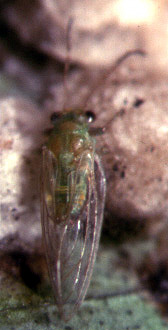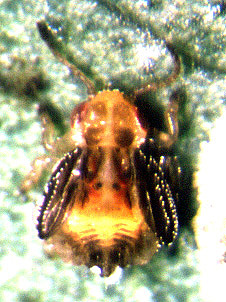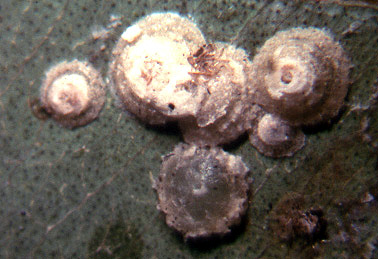back
to Farmer Fred home page
FEATURE OF THE WEEK
Here Comes the Red Gum Lerp
Psyllid
by Fred Hoffman
For the last five years, agriculture
officials around the state have been monitoring the advance of the
redgum lerp psyllid, an insect that has quickly spread from initial
sightings in the leaves of eucalyptus trees in El Monte and Fremont.
And now we have them here, too.

The Adult Redgum Lerp
Psyllid
Most noticeable on the redgum variety of
eucalyptus (Eucalyptus camaldulensis), this small, fly-like insect -
usually yellow or green in color, about an eighth of an inch long -
is recognizable by its "lerp", a white, crystallized structure of
honeydew on the underside of the leaves, which serves as protection
for the larvae. The damage this sucking insect causes is quite
noticeable: massive leaf drop along with sticky honeydew secretions,
a mess for windshields and shoe bottoms alike. This premature
defoliation of the trees could eventually weaken and destroy an
infected eucalyptus. Experts guess that an unwitting traveler brought
the redgum lerp psyllid to the U.S. from Australia, perhaps as a
hitchhiker on a wreath made of eucalyptus leaves.

The Immature Redgum Lerp
Psyllid
So, what can be done to battle this pest from
Down Under? Unfortunately, at this time, not much. Experts, including
U.C. researcher Dr.Donald Dahlsten, are now combing Australia, the
original home of the eucalyptus tree, for a predatory wasp, one of
the psyllid's natural enemies. In the meantime, a couple of native
lady beetle varieties are munching on the psyllids here, offering
some more natural control.

These are the "lerps" - protective
shells for the redgum psyllids
If you spot those distinctive, white crystals
on the underside of your redgum eucalyptus, a strong blast of water
from your hose can help dislodge them. Making sure your trees are
getting summer water can help keep the tree healthy. Most of the
damage appears limited to the redgum variety, with some sporadic
outbreaks on others where it does less damage. A good piece of
insurance: avoid planting the redgum eucalyptus. Also - and this is
true whenever you're thinking of installing a lot of one kind of tree
or shrub - plant several different varieties to reduce the chances of
a pest or disease playing havoc with all your hard work. And when
traveling to a foreign country, fight the urge to return with any
fruit or plant material.
Thanks to Dr. Don Dahlsten, U.C. Researcher,
for the pictures. For more information about the redgum lerp psyllid,
visit his website:
http://www.cnr.berkeley.edu/biocon/dahlsten/rglp/RLP_Main.htm
REDGUM LERP PSYLLID UPDATE:
U.C. Berkeley environmental science professor, Dr.
Donald Dahlsten, returned in early September from Australia (where
the eucalyptus tree and the lerp psyllid originated), with a friend
in hand. There, Dahlsten discovered a small, parasitic wasp that
attacks the psyllid by laying its eggs inside the insect, killing it.
It could take a year or more before it's known
whether the wasps, currently in quarantine at UC Berkeley, will be
released in California. Dahlsten is hopeful they will prove safe. He
believes the wasps feed only on lerp psyllids, but says it remains to
be proven that they won't pose a danger to other insects. "Everybody
wants the parasites," said Dahlsten. "Especially people in Los
Angeles have been pressing me, saying, 'we need to release right
away,' but I won't do this. We need to make sure it's safe.
"


